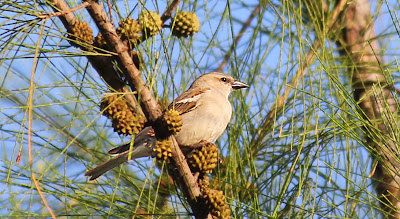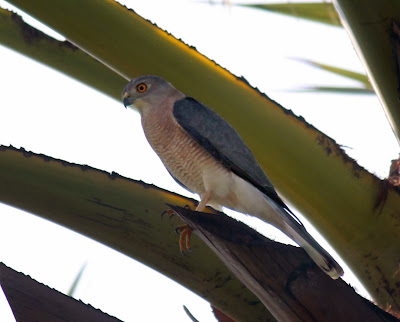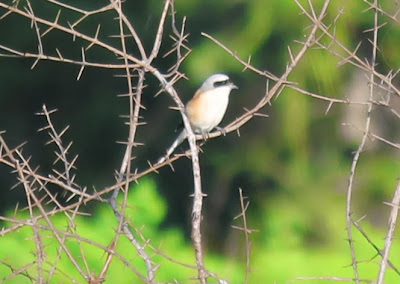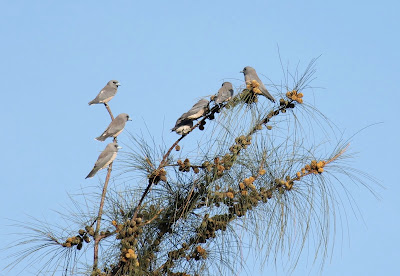| Yellow-Throated Sparrow | ||
|---|---|---|
| Description | 01. | It has a finer bill than typical sparrows and unlike them has no streaks on the plumage. |
| 02. | The white double wing bar on the shoulder is diagnostic on the otherwise dull grey-brown sparrow. | |
| 03. | Males have a chestnut shoulder patch. | |
| 04. | They also have a pale yellow spot on the throat in fresh plumage. | |
| 05. | Females are duller and lack the chestnut shoulder patch. | |
| 06. | The yellow spot is much reduced or lacking in females. | |
| 07. | This species is tree-loving although sometimes seen on wires and hopping on the ground. | |
| 08. | The usual call is a "chirrup" but the song is distinctive and repetitive "chilp chalp cholp". | |
| 09. | It has a bounding flight and dips deeply before rising up. | |
| Habitat | 10. | Found in Asia. |
| 11. | It is found in forest, gardens and open scrub habitats. | |
| Behaviour | 12. | The species breeds in tree hollows from April to July, often making use of the holes made by primary hole-nesting birds such as barbets and woodpeckers. |
| 13. | They may also make use of hollows on buildings. | |
| 14. | The nest is built mainly by the female. | |
| 15. | The female alone incubates the eggs. | |
| 16. | The eggs hatch after about 12 to 14 days. | |
| 17. | They roost communally in low bushes. | |
| 18. | Some populations are migratory, moving in response to rains. | |
| 19. | They feed mainly on grains but also on insects, nectar and berries. | |
| Distribution | 20. | The Chestnut-shouldered Petronia is found from Turkey into Iran, Afghanistan, Pakistan, India, Bangladesh and as a vagrant in Sri Lanka and possibly parts of Myanmar. |
| 21. | It is found in forest, gardens and open scrub habitats. | |
| Source : Wikipedia | ||
 |
| 2. Caterpillar |
Audio Credit : David Edwards, Vietnam
http://www.xeno-canto.org/browse.php?species_nr=&query=indian+roller&dir=0&order=loc3| Indian Roller | ||
|---|---|---|
| 01 | Found widely across tropical Asia | |
| 02 | Best known for the aerobatic displays of the male during the breeding season. | |
| 03 | Seen perched along roadside trees and wires and in open grassland and scrub forest habitats. | |
| 04 | It is not migratory, but undertakes some seasonal movements. | |
| 05 | Is a stocky bird about 26–27 cm long. | |
| 06 | The breast is brownish. | |
| 07 | The crown and vent are blue. | |
| 08 | The primaries are deep purplish blue with a band of pale blue. | |
| 09 | The tail is sky blue with a terminal band of Prussian blue and the central feathers are dull green. | |
| 10 | The neck and throat are purplish lilac with white shaft streaks. | |
| 11 | The bare patch around the eye is ochre in colour. | |
| 12 | Have a long and compressed bill with a curved upper edge and a hooked tip. | |
| 13 | The nostril is long and exposed and there are long rictal bristles at the base of the bill. | |
| 14 | They perch mainly on 3—10 metre high perches and feed mostly on ground insects. | |
| 15 | Nearly 50% of their prey are beetles and 25% made up by grasshoppers and crickets. | |
| 16 | During summer, they may also feed late in the evening and make use of artificial lights and feed on insects attracted to them. | |
| 17 | Holes created by woodpeckers or wood boring insects in palms are favoured for nesting in some areas. | |
| 18 | The normal clutch consists of about 3-5 eggs. The eggs are white and broad oval or nearly spherical. | |
| 19 | Both sexes incubate the eggs for about 17 to 19 days. | |
| 20 | The call of the Indian Roller is a harsh crow-like chack sound. | |
| 21 | The Indian Roller has been chosen as the state bird by the Indian states of Andhra Pradesh, Bihar, Karnataka and Odisha. | |
| Source : Wikipedia | ||
Audio Credit : Sagar Chandane, India
http://http://www.xeno-canto.org/recordist.php?id=ZESCHIPGNJ| Shikra | |
|---|---|
From Wikipedia, the free encyclopedia | |
| 01 | Found widely distributed in Asia and Africa. |
| 02 | Is a small raptor 26–30 cm long |
| 03 | Has short rounded wings and a narrow and somewhat long tail. |
| 04 | Adults are whitish on the underside with fine rufous bars while the upperparts are grey. |
| 05 | The lower belly is less barred and the thighs are whitish. |
| 06 | Males have a red iris while the females have a less red (yellowish orange) iris and brownish upperparts apart from heavier barring on the underparts. |
| 07 | The females are slightly larger. |
| 08 | The mesial stripe on the throat is dark but narrow. |
| 09 | The central tail feathers are unbanded and only have a dark terminal band. |
| 10 | Juveniles have dark streaks and spots on the upper breast and the wing is narrowly barred while the tail has dark but narrow bands. |
| 11 | A post juvenile transitional plumage is found with very strong barring on the contour feathers of the underside. |
| 12 | The call is pee-wee. |
| 13 | In flight the calls are shorter and sharper kik-ki ... kik-ki. |
| 14 | The Shikra is found in a range of habitats including forests, farmland and urban areas. |
| 15 | They are usually seen singly or in pairs. |
| 16 | The flight is typical with flaps and glides. |
| 17 | During the breeding season pairs will soar on thermals and stoop at each other. |
| 18 | They feed on rodents, squirrels, small birds, small reptiles and insects. |
| 19 | They will descend to the ground to feast on emerging winged termites |
| 20 | Hunt at dusk for small bats |
| 21 | The breeding season in India is in summer from March to June. |
| 22 | The nest is a platform similar to that of crows lined with grass. |
| 23 | Both sexes help build the nest, twigs being carried in their feet. |
| 24 | The usual clutch is 3 to 4 eggs |
| 25 | Eggs are pale bluish grey stippled on the broad end in black. |
| 26 | The incubation period is 18 to 21 days. |
Audio Credit : Sander Bot
http://http://www.xeno-canto.org/recordist.php?id=HZKCNRIPRH| Bay-backed Shrike | |
|---|---|
From Wikipedia, the free encyclopedia | |
| 01 | Resident in South Asia. |
| 02 | It is smallish shrike at 17 cm, |
| 03 | Maroon-brown above with a pale rump and long black tail with white edges. |
| 04 | The underparts are white, but with buff flanks. |
| 05 | The crown and nape are grey, with a typical shrike black bandit mask through the eye. |
| 06 | There is a small white wing patch, and the bill and legs are dark grey. |
| 07 | Sexes are similar, but young birds are washed-out versions of the adults. |
| 08 | Percheing on a bush, it sallies after lizards, large insects, small birds and rodents. |
| 09 | Prey may be impaled upon a sharp point, such as a thorn. |
| 10 | Thus secured they can be ripped with the strong hooked bill, but its feet are not suited for tearing. |
| 00 | It is a widespread resident breeder in Afghanistan, Pakistan and India, Sri Lanka. |
| 00 | It nests in bushes in scrubby areas and cultivation, laying 3-5 eggs. |
| Ashy Woodswallow - சாம்பல் தகைவிலான் | |
|---|---|
From Wikipedia, the free encyclopedia | |
| 01 | Sometimes called the Ashy Swallow-shrike is a woodswallow which is found in south Asia. |
| 02 | Has a short curve bill and a short square tail and long wings. |
| 03 | Usually seen perched in groups, high on powerlines, tall bare trees and most often in areas with a predominance of tall palm trees. |
| 04 | In flight, the broad base to the wings gives it a very triangular outline |
| 05 | This stocky woodswallow has an ashy grey upperparts with a darker head and a narrow pale band on the rump. |
| 06 | The underside is pinkish grey and the short slaty black tail is tipped in white. |
| 07 | The finch-like bill is silvery. |
| 08 | The first primary is very short. |
| 09 | There are no geographic variations in plumage and no subspecies have been designated. |
| 10 | Males and females are indistinguishable in the field. |
| 11 | Young birds appear barred on the underside. |
| 12 | Habitat and distribution |
| 13 | Woodswallows are found in a range of habitats from the plains to about 2000 m, over cultivated areas, in forest clearings and often in areas with tall palm trees. |
| 14 | The species is widely distributed across India, Nepal, Sri Lanka, Thailand, Burma, Laos, Malaysia and China. |
| 15 | Length 190 mm (7.5 in), Weight 37–42 g (1.3–1.5 oz) |
| 16 | Ashy Woodswallows are usually seen in small groups. |
| 17 | Several birds may sit huddled side-by-side. |
| 18 | Insects may be caught in the beak, transferred and held in their feet, torn up with their bill and swallowed without returning to the perch. |
| 19 | Known to visit bird baths. |
| 20 | Although mainly feeding on insects, they may take nectar from flowers |
| 21 | The breeding season is March to June. |
| 22 | The nest is a shallow cup placed at some height. |
| 23 | The clutch consists of 2–3 greenish white eggs with brown spots. |
| 24 | Both parents take part in nest building, incubation and feeding the young. |
| 25 | They will mob larger birds such as crows and birds of prey |
| 26 | The song consists of a varied combination of wheezy notes that may include imitations of the calls of other birds. |
| 27 | The usual call is shrill nasal chewk. |
| 28 | They make seasonal movements, possibly in response to rainfall. |








No comments:
Post a Comment